|
Avalon Permit
Fly
By Hans van Klinken
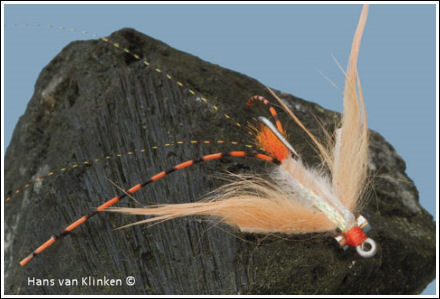
Secret
ingredient to a Cuba grand slam
I
recently caught my first saltwater grand slam - a permit, tarpon,
and bonefish in a single day - while fishing in Cuba. While this
event was special to me, what made it more exciting was my
discovery that many others have been doing the same, thanks in
large part to a new permit fly developed by Mauro Ginevri.
While most permit flies
imitate crabs, in Cuba the permit feed heavily on shrimp,
leading Ginevri to develop a shrimp pattern that sinks quickly
in deeper water, swims upright, and most importantly catches
fish.
So far, the Avalon
Permit Fly has accounted for 134 permit in Cuba alone, and more
results are starting to come in from other parts of the
Caribbean. In the evenings during my visit there, I had several
chats with Ginevri about his new pattern. I enjoy learning how
other tiers think, and how they work. Of course we also talked a
lot about the techniques and materials he used to develop his
final creation.
I was privileged to
learn each tying step from the original designer. Certain
proportions of the Avalon Permit Fly are so crucial that if one
of them is incorrect, the success of fly is degraded. I am
grateful that Ginevri asked me to help him publish his pattern
to prevent other tiers from incorrectly imitating it.
Mauro Ginevri was born
in Civitanova Marche, Italy, in 1963. Since 2000, he has fished
diligently for Cuban permit, using mostly crab and shrimp
patterns, some tied by the world’s most famous saltwater tiers.
Many flies were also given to him by lodge guests, but due to
lack of success, he began tying his own flies in 2001. Today,
his greatest passion is tying bonefish, permit, and tarpon
flies.
Like most other fly
fishers, Ginevri noticed how easily permit become alarmed by the
fly, or how they follow the fly during the first two or three
strips, and then suddenly spook and change direction. At the
same time, he noticed that many flies meant to fish with the
hook point up, actually rolled over onto their sides when
stripped. These two facts, he thought, were probably related.
It became an obsession
for him to develop a shrimp pattern that sinks quickly, and
stays hook up at all times, regardless of retrieval speed. He
started to design and develop many creations, and each of them
went through intensive tests in a swimming pool, observed while
snorkeling. Underwater, Ginevri studied the action, position,
mobility, sinking speed, and behavior of each prototype.
In 2007 one of Mauro’s
customers showed him a fly with a beaded keel system. The
monofilament keel weighted with stainless steel or silver beads—gives
the fly extra weight, and to keeps the fly in the hook-up
position while fishing.
The beads move freely on
the monofilament, allowing them to clack or snap when the fly
moves. This audible cue may be a trigger—at the very least it
does not put the fish off. The two pieces of Zonker strip tied
in a delta-wing position prevent the fly from rolling over, even
when retrieval speeds are changing.
The Avalon Permit Fly is
a shrimp pattern, but why is it so long? While studying the
flats of Cayo Largo, guides pulled a net over distances of
almost 100 meters, and on nearly every run they made, discovered
at least a dozen or more shrimp that were 9 centimeters or
longer. That’s why the Avalon Permit Fly does not come in a
range of sizes—the #2 hook and the material lengths provided in
the recipe create a perfectly balanced fly that rides hook up,
and imitates the larger shrimp permit prefer.
On April 26, 2009,
Ginevri was finally satisfied with his final design, and gave
the flies to six customers to try in Cayo Largo that week. The
result that week was five permit landed, and overall, much
better reactions to the fly. The fly has become so popular in
the past year, and so credible with the guides, that only two
permit have been caught at Cayo Largo using other flies.
Avalon Permit Fly
Hook: #2 Tiemco 811S.
Thread: Tan 140-denier UTC Ultra Thread.
Eyes: Silver or gold 3 mm dumbbell eyes.
Keel: Hard 20-pound nylon monofilament with four 2.8 mm
silver or stainless steel beads.
Mouth: Arctic fox tail dyed yellow/orange (1 cm).
Antennae: Black or wine Krystal Flash (7 cm).
Legs: Two strands of medium orange, Hareline Grizzly
Barred rubber (5 cm).
Shellback: Two strands of Pearl Diamond Braid.
Body: Tan marabou.
Claws: Two straight-cut light tan or gray Zonker strips
tied delta wing (skin 2 cm, hair 4 cm).
Head: Fluorescent orange 210-denier UTC Ultra Thread.
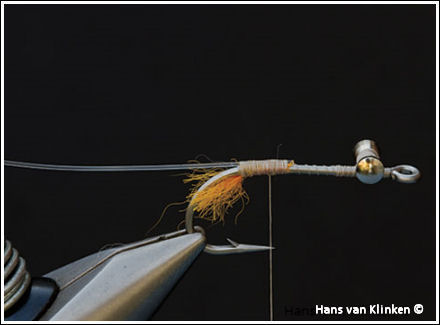
Step 1
Insert the hook into the vise, and attach the thread. Secure
dumbbell eyes on top of the shank with a series of figure-eight
wraps. Use Super Glue to ensure the eyes do not twist in the
powerful crushers of a permit’s mouth. Secure an 8 cm section of
20-pound nylon monofilament to the top of the shank. Tie in a
small bunch of Arctic fox (3 cm) to the underside of the hook
shank. After the fibers are secure, trim the tips to about 1 cm.

Step 2
Tie in two black or wine Krystal Flash fibers one at a time on
the left and right sides of the shank.
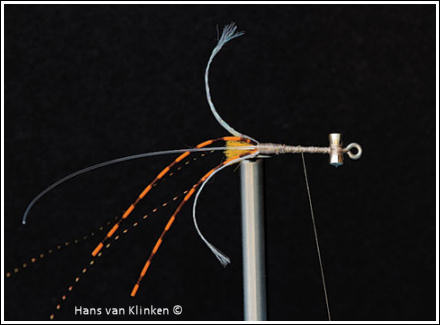
Step 3
Tie in two Grizzly Barred rubber legs one at a time, positioned
symmetrically on the left and right sides of the hook. Trim them
to 5 cm. Attach two strands of Pearl Diamond Braid in the same
position and trim them slightly shorter (4 cm).
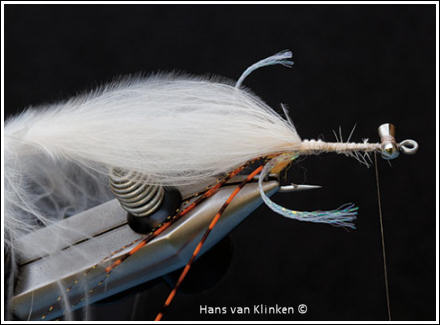
Step 4
Tie in a large tan marabou feather by its tip at the rear of the
hook shank.
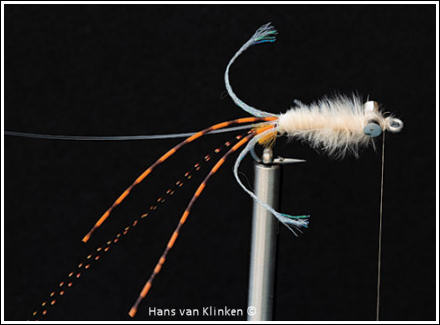
Step 5
Wrap the marabou feather forward and secure it. Cut off the
excess.
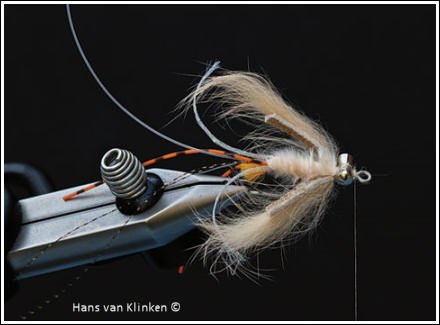
Step 6
Tie in the Zonker strips one by one on each side of the hook
shank just behind the dumbbell eyes. To create the ideal
delta-wing shape, apply extra tension on the last few wraps of
thread.

Step 7
Pull the Pearl Diamond Braid strands forward one at a time and
secure them to the left and right sides of the hook eye.
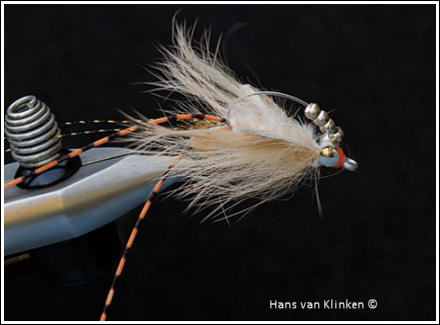
Step 8
Thread four silver beads onto the monofilament keel and pull the
monofilament forward to create a loop 2 cm long and 1 cm deep.
Secure the monofilament at the hook eye and whip-finish. Use
fluorescent orange thread to finish the head, and add a sturdy
coat of head cement.
Hans van Klinken is the
commander of the Royal Dutch Army Gunnery School. He has tied
flies since 1976 and is the originator of the
Klinkhåmer Special.
Text and photos
by
Hans van Klinken
©
|